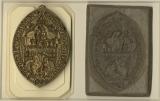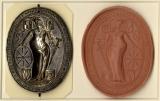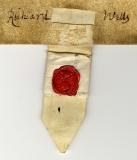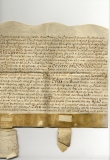Balliol College Archives & Manuscripts |
Back to: HOME > Archives and Manuscripts > Exhibitions Index
Ecclesiastical Patronage
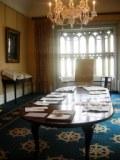
Introduction
The College has had ecclesiastical patronage from its earliest days. Indeed, it received one of its first substantial Benefactions, the Advowson of the Living of St Lawrence Jewry in London, in 1294. Numerous Advowsons were acquired by gift, legacy or purchase during the following seven centuries. In the early days, the College’s interest was two-fold. In the first place, there was often agricultural land and property associated with the Living from which the College could draw income. In the second place, the Livings provided a career path and route to matrimony for young Fellows of the College. Until the mid-nineteenth century, all Fellows had to be ordained priests within a few years of election, and all were (or were supposed to be) celibate. The great majority would have been young men whose only hope of settling into married life was to accept a College Living. The importance of finding a patron and a living is key to the plots of many of the novels of e.g. Jane Austen and Anthony Trollope.
The College no longer owns any land in any of the Parishes where it has had or retains the Advowson, and the use of the Livings as early retirement homes for Fellows (many of whom served the Parishes to which they were appointed long and well) came to an end in the 19th century when the law concerning the requirements of celibacy and ordination for Fellows was changed. Some have therefore thought in recent times that for an institution like Balliol to continue as an ecclesiastical patron is an anachronism. Perhaps in some small degree it is, but with it comes an ongoing connection between the College, and especially its Chaplain and Chapel, and Parishes all over the country. We believe that the Parishes concerned welcome the association. Indeed some years ago, when the law on ecclesiastical patronage changed, some Fellows thought we should let the connection lapse. As a compromise, it was agreed that we should leave the matter to the Parishes concerned, and all were asked whether they would like this, which would presumably have devolved the responsibility of appointment entirely on to the Bishop. All the Parishes except one responded in favour of continuing.
The advowson of St Lawrence Jewry was lost through diocesan reorganisation in 1951, when it was assigned to the Corporation of the City of London, but there is still a stall in the Church which is reserved for the Master of Balliol, and the Corporation of London still pays a corn rent to the College in respect of part of its Guildhall site.
Notes are given in turn below on each of the items selected for display. The items concerning patronage are a very small proportion of the total material in the Archives. The selection is intended to represent typical series of administrative documents related to the relationship between the college and its livings rather than 'treasures' or 'highlights'. Documentation concerning the acquisition of the Advowsons you would expect, but it sometimes surprises people to learn that it is not uncommon for the documentation to pre-date the acquisition by several centuries owing to the old practice of handing over the entire documentary history of a property or similar upon a change of hands. There is documentation concerning the appointment of Incumbents; disputes were always common in any kind of business to do with land; and from modern times we have not only voluminous correspondence but also quite often Church guides, postcards, etc, etc. The volume of material varies from many thousands of items, as in the case of Long Benton, to just a handful.
For a detailed account of the history of the College, which cites other sources profusely, see Balliol College. A History, 2 nd edition revised, 2005, ISBN 0-19-920181-1. More information about Balliol's current and historical ecclesiastical patronage is available on these pages.
Catalogue images and item descriptions
-click on the image for a larger version
 |
1. Royal Charter of Incorporation of Elizabeth I, 15881588 was Armada year, and England was in politico-religious turmoil. Any institution whose corporate identity appeared to depend on the Pope, like Balliol, was vulnerable, and the College went to much trouble and expense to procure this Royal Charter of Incorporation. Bearing the Great Seal of Queen Elizabeth I, it defines the still current proper corporate designation of the College: The Master and Scholars of Balliol College in the University of Oxford. It was found rolled up and neglected in a College broom cupboard some twenty-five years ago. Its conservation and mounting for occasional display was paid for by an anonymous Benefactor. F.11.6 Transcription of Latin text, English translation More images: high resolution text only, initial portrait, lion detail, dragon detail, seal |
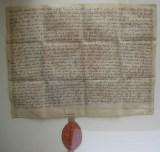 |
2. Dervorguilla's Statutes, 1282Dervorguilla of Galloway, Lady of Balliol, sealed these first Statutes for the College in 1282 at her Castle of Buittle near Dumfries. Only one side of her seal can be seen; both sides are shown on the cover of the College’s Guidebook. D.4.1 The 1282 Statutes are transcribed in HE Salter's Oxford Balliol Deeds (1913) and translated in JH Jones' Balliol College: A History (2005). More images: high resolution text only |
3. College seals 1282 and 1588 with modern impressionsIt was usual for medieval institutions such as colleges or religious houses to have two seals. A sigillum commune, or common seal, far from being common in the sense of 'ordinary', was used for important documents, expressing the common will of the Master and Fellows. A sigillum ad causas is for day to day use on current business documents or less important records. We have no surviving examples of an impression of the sigillum ad causas. a) Common seal (prob. 1282). Probably given by Devorguilla in 1282; the earliest known use of the first bronze matrix is 1341, and the latest 1575. 77 x 58 mm. A most poignant document was sealed with this matrix in 1534. In that year, the Act of Supremacy established the King to be the “supreme head on earth of the Church of England”. All colleges and similar institutions were required to acknowledge this, and around 170 formal submissions survive in the National Archives. Balliol’s is the only one to record a protest. Underneath the Seal is written, signed by the Master and five Fellows, “We have appended our seal to this deed and signed our names having maintained that we intend nothing to prejudice divine law, the rule of the orthodox church, or the doctrine of Holy Mother Catholic Church”. They were lucky to survive; a generation later a least two members of the College were hanged, drawn, and quartered for their Catholic faith. MISC 24* b) Sigillum ad causas, medieval (date unknown). 50 x 21mm. c) Common seal (1588). 80 x 69mm. In 1588 the ancient seal, bearing the then uncomfortably Catholic image of the College under the protection of the Blessed Virgin Mary, was replaced with a new one showing St Catherine of Alexandria as a buxom Brittania-like figure. This matrix remained in use until modern times. |
|
 |
4. First Latin Register (f.46, 1539)This volume covers a wide variety of College business, initially in rather scrappy fashion, from 1514, mostly in Latin. It is open at page 46, which records three appointments to livings – St Lawrence Jewry, Fillingham and Brattlby – one of them disputed. With a copy of Early History of Balliol College open at a translation, page 268. Government B1 Early History of Balliol College, 1891 |
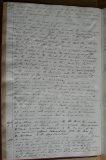 |
5. First English Register (p. 36, 1815)This volume, open at fo.34 (1815), is the first detailed systematic record of College business in English. It contains frequent patronage business. On 19 November 1815 the rebuilding of St Botolph’s and the union of St Botolph’s and All Saints, Colchester were discussed. Government C |
 |
6. Computi (p.37, 1621)The two Bursars were required to present accounts to a meeting of the Master and Fellows twice-yearly until the mid-nineteenth century. They were personally liable for any shortfall, so good records were kept. We have a complete run of their accounts from 1568; detailed notes from an earlier volume started in 1544 survive in the Bodleian Library but that volume was lent with many others to the Revd. Andrew Clark (1856-1922). All the other volumes found their way back, but this volume cannot now be traced, a painful lesson. The volume (1615-1662) selected for exhibition is open at page 37 (Luketide account, 1621). Well over half the College’s rental income (practically its only income) was derived from Abbotsley and Long Benton (Michell: Benton): see on the right under Reditus recepti and Reditus frumentarius (lines 1 and 3 in both cases). Bursars’ Books I.B |
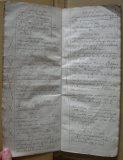 |
7. Treasury Book (p.2-3, 1637-1642)Until the Chapel was rebuilt in 1854, there was a secure annexe entered through the Chapel Sanctuary which was called the Treasury. Title Deeds, and, until the late eighteenth century when the College started to use banks, cash, were kept there. The earliest Treasury Book, a Register of comings and goings of cash and important documents such as leases and bonds, begins in 1637. The entries from January 1637 (= January 1638 in modern dating) to July 1642 are shown; they include tracking records of documents coverning College interests at Long Benton (Mickle Benton) and St Laurence Jewry. The tracking system worked: the original documents are still in our hands. There is a frustrating entry bottom right. During the English Civil War, the College ran into severe financial difficulty because many of its rents were uncollectable, and the King, besieged in Oxford, took all the available cash to pay his army. This was recorded in the Treasury Book as a 'willingly' made loan, still outstanding. Over the page are noted similar never repaid “loans” to the King of more cash and all the silver except the Chapel plate. Bursars’ Books I.E |
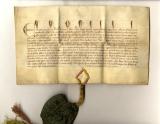 |
8. Licence in Mortmain of Edward III regarding the Advowson of Long Benton, 1366This document, which has the Great Seal of King Edward III attached with its original silk plait, records the royal approval of the Conveyance of the Advowson of Long Benton (Mikelbenton) to the College (Aula). E.1.6 b Transcription of Latin text, English translation More images: high resolution text only, seal (face), seal (dorse) |
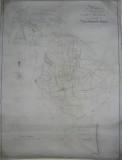 |
9. Plan and survey book of Long Benton, 1801-1802This plan is accompanied by the corresponding Survey Book. Estates. Map 17 E.2.38 |
 |
10. Act of Parliament regarding the Advowson of Huntspill, 1778The Rectory of Huntspill was the Master’s perquisite when first acquired, but no Master ever resided there. In 1778 an Act of Parliament was procured whereby the Parish had a proper resident Incumbent and the Master a stipendiary payment of £300 p.a. out of the Rectory endowments. This continued until recent times when a Fellow persuaded the College that this payment out of diocesan funds was an anachronism. The College agreed to waive its right under the Act, which has never been repealed, provided the Diocese agreed to pay £300 p.a. to Huntspill Church Building Fund. C.17.29 b |
 |
11. Terrier of Timsbury, ca. 1700 copy of 1634 surveyThis records a detailed survey of the property of the Rectory of Timsbury made by the Rector, two Churchwardens and two Sidesmen in 1634. C.13.8 More images: lower half of terrier |
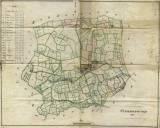 |
12. Plan of Timsbury, 19th century copy of 1784 surveyThis plan was probably made in connection with tithe redemption. C.13.21 |
|
|
13. Indenture regarding the Advowson of Timsbury, 1700This tripartite indenture between Richard Kidder, Bishop of Bath & Wells, Sir Anthony Deane, and the College, records the transfer of the Advowson of Timsbury, with complex terms designed to ensure a resident Rector, the College apparently being chosen as trustworthy “in Consideration of the good order Discipline and Government now exercised in the same College by which the same is brought into a flourishing Estate”. The seals of the Bishop (who also signed) and the College are appended. The ordinary procedure would have been that each of the three parties to the indenture would have received a copy sealed by the other two; we do not know how the College ended up with the wrong copy. C.13.20 |
14. Conveyance of the Advowson of South Luffenham, 1855This deed records the purchase of the Advowson by the College for £1610.7s.6d. E.10.38 |
|
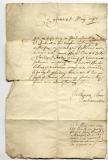 |
15. Parliamentary Order regarding Duloe, 1648This is an Order made on 25th May 1648 which begins “Delivered by the Commons in Parliament assembled”, requiring the Institution and Induction of James Forbes, Clerk, to the Vicarage of Duloe. This document predates the College's patronage of Duloe and illustrates the common practice of an entire documentary heritage accompanying transfers of property. C.22.9 f Transcription of text |
16. Particulars and Valuation of the Advowson of Tendring 1876The purpose of this survey is not clear, but it records much interesting detail about the Parish. C.23.30 |
|
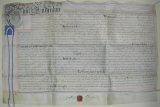 |
17. Conveyance of the Advowsons of Tendring, St Botolph and Allan Saints to the College, 1714This deed records that Hatton Compton, son and executor of Henry Compton, was following his father’s declared wishes in conveying the three Advowsons to the College. C.23.17 |
 |
18. Notarial document concerning Abbotsley, mentioning John Wyclif as Master, 1361The earliest Master of the College for whom we know the exact date of election is Thomas Cisson, 1511. We cannot even be certain that we know the names of all his predecessors, because they can only be identified by chance appearances. That is how we know that John Wyclif was Master – the 1361 document shown describes him as such (line 10) in the course of certifying that he had been given authority to act for the College in appropriating the Rectory of Abbotsley, the Advowson of which we still have. The certificate was drawn up by a Public Notary; the elaborate device drawn bottom left is his personal signum or authentification. E.7.9 Transcription of Latin text, English translation More images: main text only, detail of notarial signum, text of notarial statement |
 |
19. Conveyance of the Advowson of Ulceby, 1942Ulceby is the College’s most recently acquired Advowson. It was left to Balliol by the Revd. WG Peacock, Rector and Patron, subject to the incumbency of the Revd. EH Fletcher. This document includes one of the last uses of the 1588 seal. I.4.2 More images: full text |
20. Advowson of St Leonard's, ColchesterThe suggestion was made about 1909 that the College should relinquish the Advowson of St Leonard’s to the Bishop, but after careful consideration (extensive correspondence survives) Balliol decided not to, but made a declaration of trust which was in effect a renunciation of its right to sell the Advowson. Patronage Papers 29 |
|
21. Vacancy at Blunham, 1941The Living of Blunham was vacant in 1941 and correspondence about filling it survives, including a rather touching petition with multiple signatures from the parishioners concerning the Revd. Mostyn Prichard. He was appointed, and was still at Blunham in 1947. Patronage Papers 13 |
|
22. Vacancy at St Mchael's Myland, 1932In 1932 the College Livings at Huntspill and at Myland were both vacant. There is extensive correspondence about these posts in the Archives, including letters from applicants, letters of reference, etc, etc. Selected for exhibition is the letter from the Revd. WJ Wallace accepting Myland; he had actually applied for Huntspill, and the file includes a detailed letter of reference concerning his work at Clophill. He was still at Myland in 1947. Patronage Papers 30 |
You do not need to request permission to download or print one copy of any of the images on these pages for your personal private study or research purposes.
You do need to request permission in writing to use any of these images for any publication in any format, including any use on a website.
There is no charge for Archive enquiries, but donations for Archive purposes are always appreciated.
| Updated 11.viii.14
|
Balliol College All rights reserved © 2025 |

